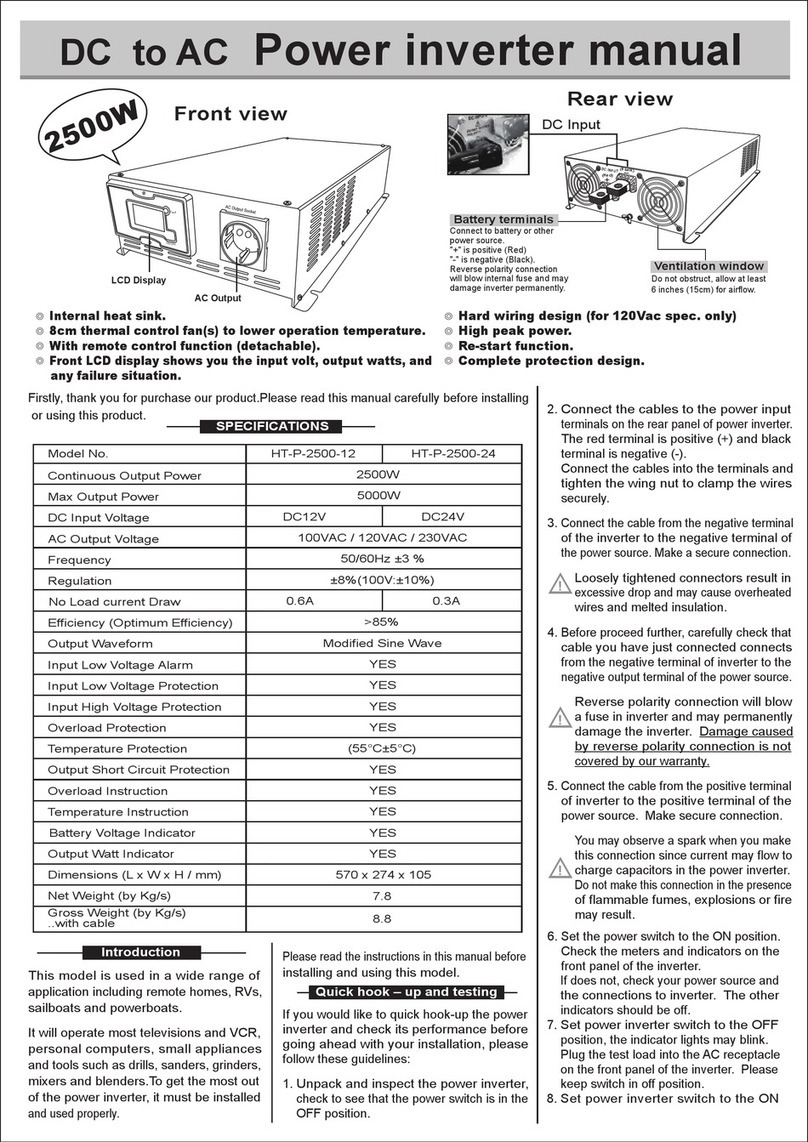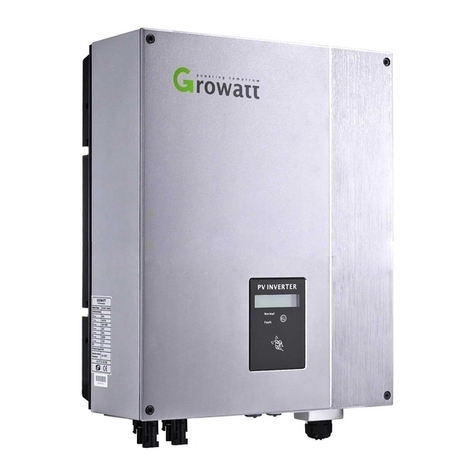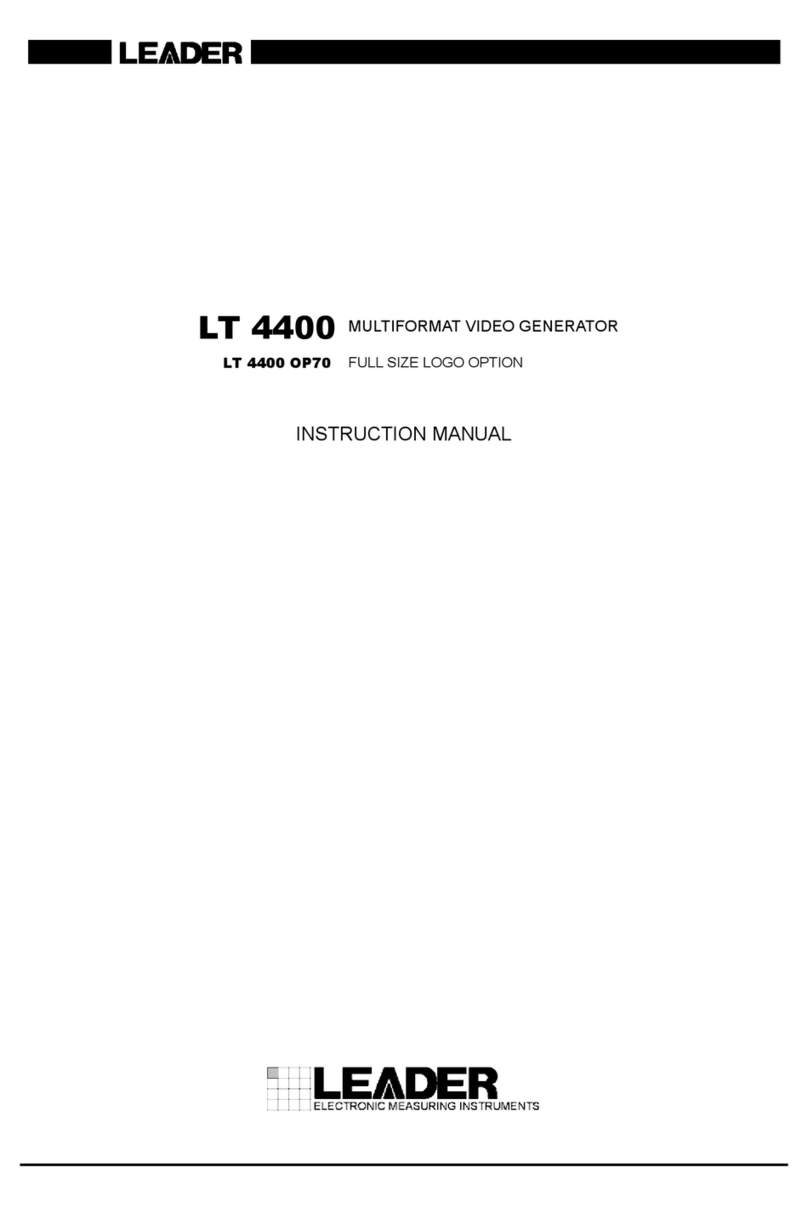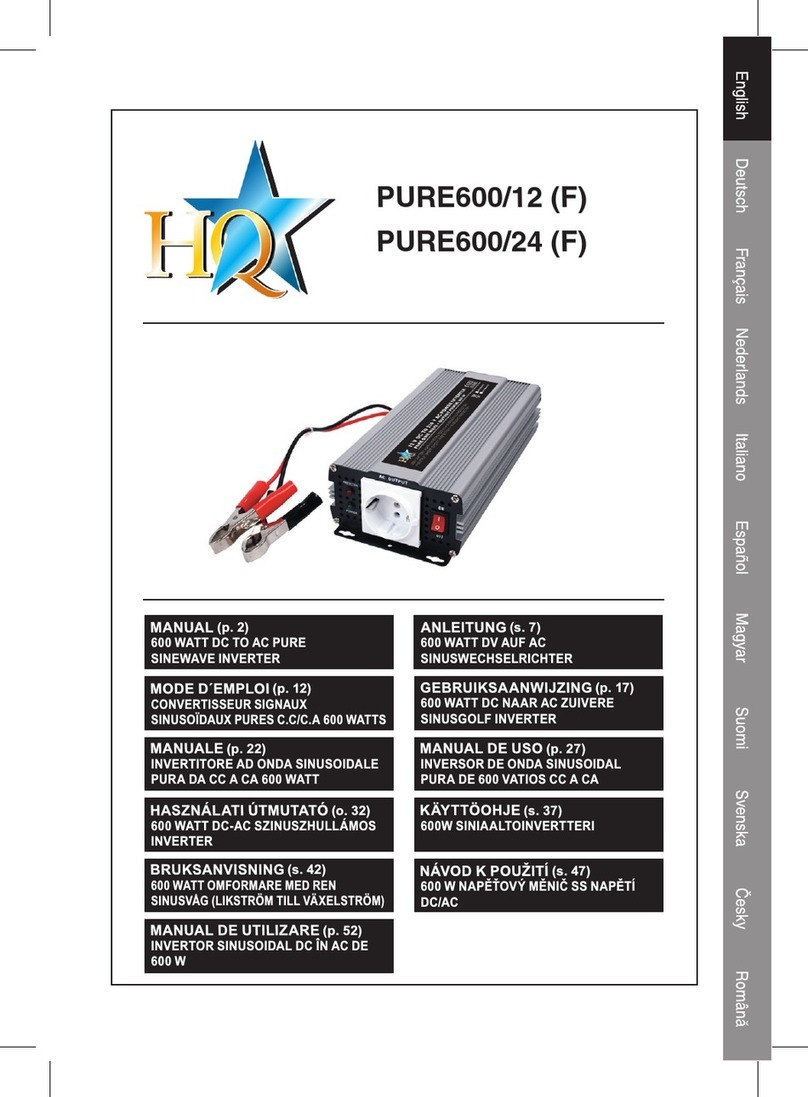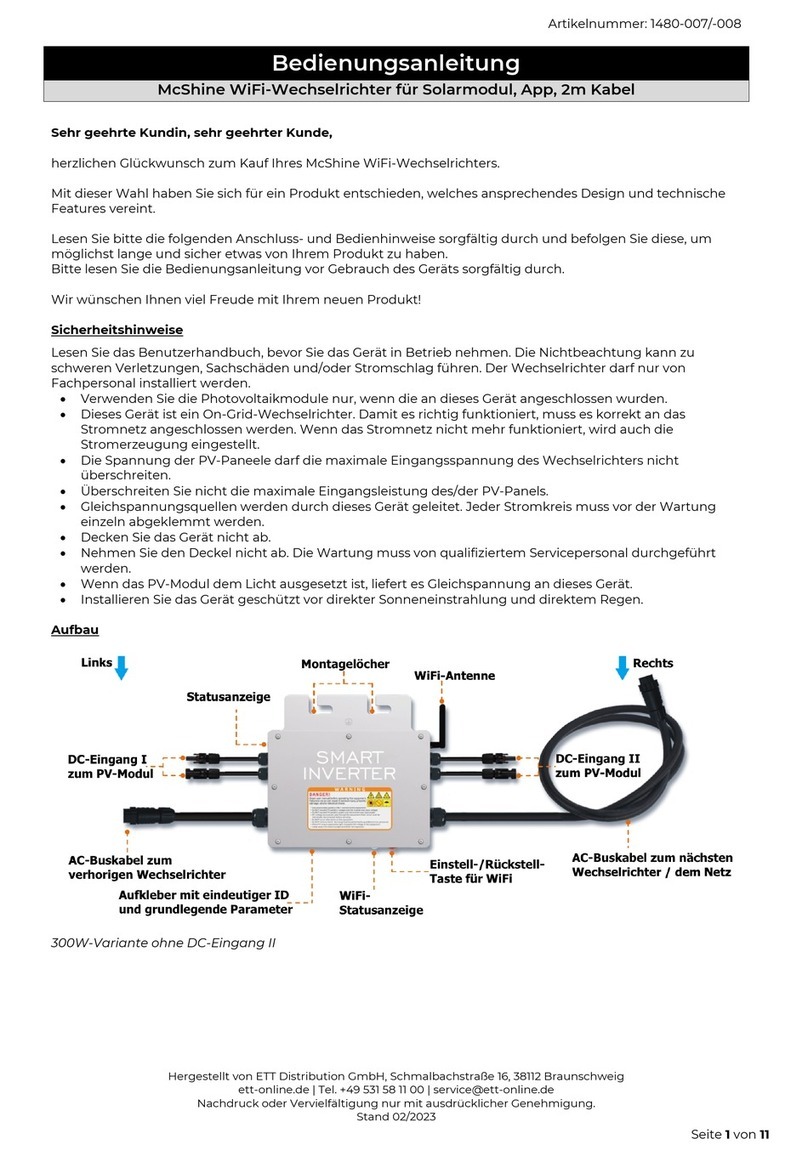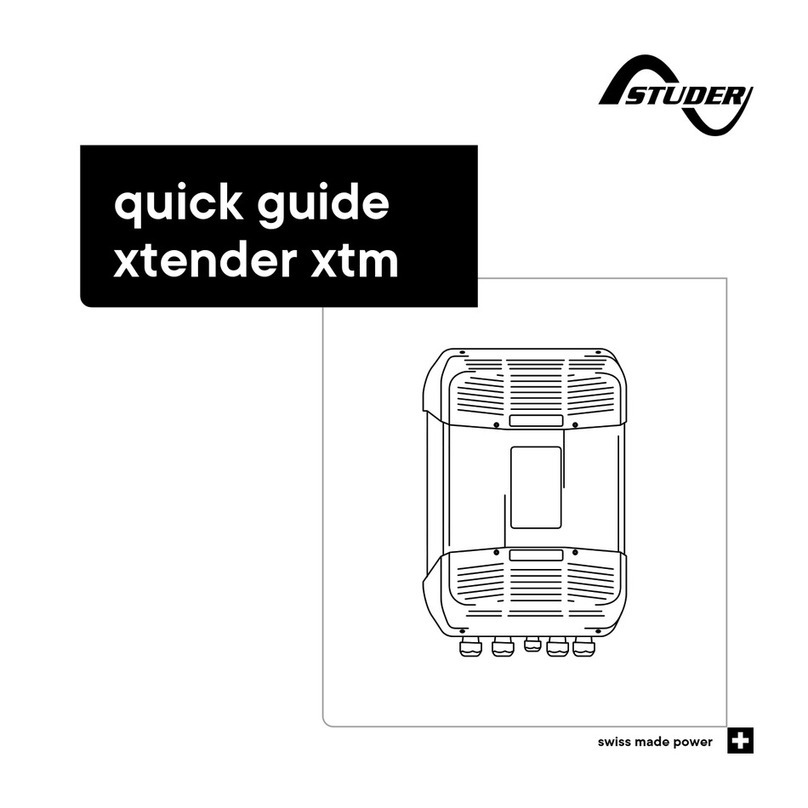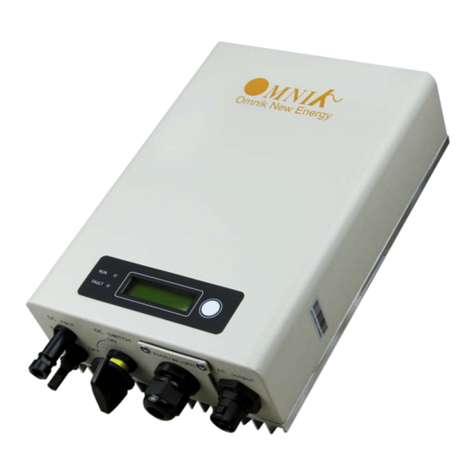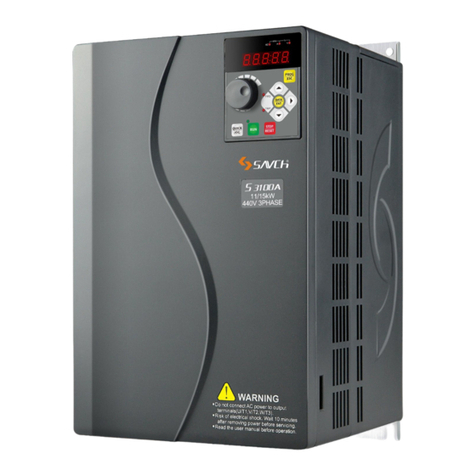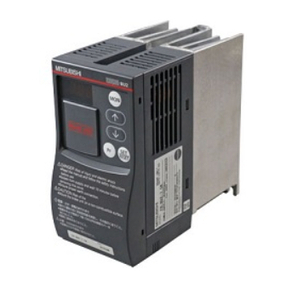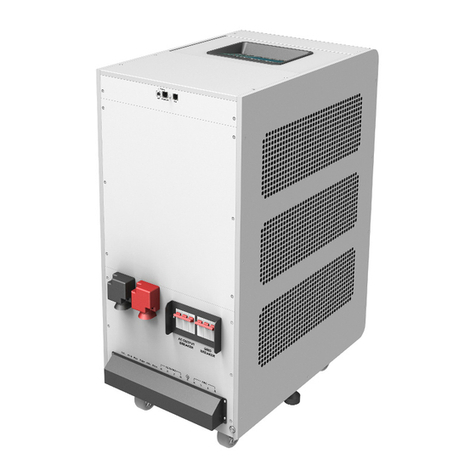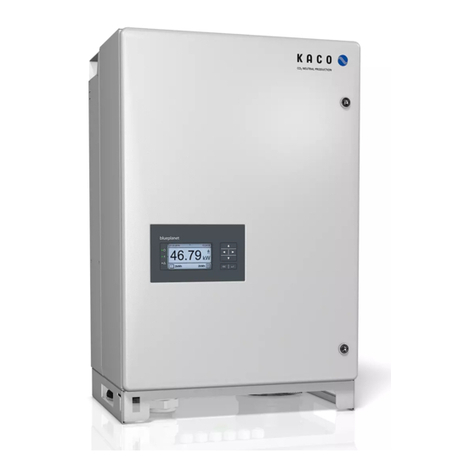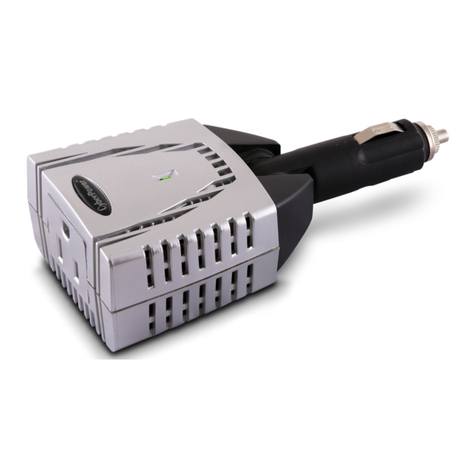Larson Electronics WCDE-6-NL User manual

WCDE-6-NL
Mobile Light Tower - 6kW Diesel Generator -
30' Tower - 30 Gal Capacity w/ 60-hr Runtime -
NO LAMPS
Manual

Preface
Please read the following instructions carefully
before starting to use your light tower.
It is a solid, safe and reliable machine, built
according to the latest technology. Follow the
instructions in this booklet and we guarantee you
years of troublefree operation.
Always keep the manual available near the machine.
In all correspondence always mention the light tower
type and serial number, shown on the data plate.
The company reserves the right to make changes
without prior notice.
Table of contents
1 Main parts - HiLight V4 W ........................ 7
2 Safety Information ...................................... 8
2.1 Operating Safety............................................8
2.1.1 Prior to use ................................................ 8
2.1.2 During operation ....................................... 8
2.2 Engine safety ................................................. 9
2.2.1 Operator safety..........................................9
2.2.2 Service safety .......................................... 10
2.2.3 Before servicing ...................................... 10
2.2.4 During servicing...................................... 10
3 Assembly .................................................... 11
3.1 Tow hitch .................................................... 11
3.2 Loose parts ..................................................11
3.3 Light fixture wiring ..................................... 12
4 Operation ................................................... 13
4.1 Safety........................................................... 13
4.2 Control panels .............................................13
4.2.1 Towing and hoisting ............................... 13
4.2.2 Before towing.......................................... 13
4.2.3 During towing ......................................... 14
4.2.4 After towing ............................................ 14
4.2.5 Hoisting................................................... 14
4.3 Location....................................................... 14
4.3.1 Deployment............................................. 15
4.3.2 Levelling the trailer................................. 15
4.3.3 Raising the tower .................................... 15
4.3.4 Lowering the tower ................................. 17
4.3.5 Engine operation ..................................... 18
4.3.6 Lights ...................................................... 19
5 Maintenance .............................................. 20
5.1 Daily inspection .......................................... 20
5.2 Lamp replacement....................................... 20
5.2.1 Servicing the engine ............................... 20
5.3 Replacement parts ....................................... 20
5.4 Wiring diagrams.......................................... 21
6 Maintenance schedule............................... 22
6.1 Dimension Drawing - 9829 3900 86........... 28
7 D900 axle with leaf springs use and
maintenance manual ................................. 30
7.1 Axle............................................................. 30
7.1.1 Safety Precautions .................................. 30
7.1.2 Maintenance............................................ 30
7.2 Operation..................................................... 30
7.3 Wheel bolt tightening torque....................... 30
7.4 U-bolt nut tightening torque........................ 30
8 Setting the Lc1003™ controller ............... 31
8.1 Push button and LED functions .................. 31
8.2 Module display............................................ 32
8.3 Home page .................................................. 32
8.4 Icon overview.............................................. 32
Larson Electronics, LLC Phone: (800) 369-6671 Fax: (903) 498-3364 www.larsonelectronics.com 2 of 33

Main parts - WCDE-6-NL
"The light tower provides an undercarriage ( frame, axle and towbar ).The light tower is very useful for construction sites where neither electricity nor lighting is
available."
Larson Electronics, LLC Phone: (800) 369-6671 Fax: (903) 498-3364 www.larsonelectronics.com 3 of 33

Safety Information
Operating Safety
Prior to use
To reduce the risk of personal injury, ensure the
surrounding area is in good order and free of
debris.
To reduce the risk of shifting, rolling, or
overturning, locate the light tower on a firm, level
surface, with enough space to deploy the trailer’s
outriggers.
Do not allow water to accumulate around the base
of the light tower.
To improve stability, deploy the outriggers prior to
raising the light tower mast.
The light tower mast can be extended to 24.6 feet
(7.5 meters) in height. Ensure the area above the
trailer is clear of obstructions.
Ensure the light tower is in good operating condition:
Check tires, lights, protective lamp covers,
electrical wiring, and the engine for obvious signs
of wear or damage.
Never use any equipment that is damaged or in
need of repair.
During operation
-Ensure the trailer is well grounded, per all
applicable regulations.
-Never raise, lower, or move the trailer while the
light tower is in use.
-Do not collapse the outriggers or move the trailer
while the light tower mast is vertical extended.
-When not in use, or in case of high winds, lower the
light tower mast to the travel position (see page
14).
-Light bulbs can be extremely hot. Always allow
bulbs to cool at least 15 minutes before handling.
WARNING
Improper use of equipment
could cause serious injury or
death.
Prior to using this product,
carefully read, understand, and
observe all instructions in this
manual and the engine manual.
CAUTION
Crush hazard.
When operating or working on
the light tower, keep hands and
body parts clear of pinch
points.
DANGER
Electric shock hazard.
Contact with overhead
electrical power lines will
cause serious injury or death.
Do not position light tower
under power lines.
WARNING
Falling equipment could cause serious injury
or death.
When raising or lowering the light tower
mast, ensure the area directly behind the
trailer is clear of people.
If the mast “hangs up” or the winch cable
develops slack while raising or lowering the
mast, stop immediately, move away from the
unit and contact Atlas Copco.
Larson Electronics, LLC Phone: (800) 369-6671 Fax: (903) 498-3364 www.larsonelectronics.com 4 of 33

Engine safety
Operator safety
CAUTION
Risk of severe burn.
Before handling lights, allow
lights to cool for 15 minutes. DANGER
Explosion hazard.
- Keep engine, fuel, and other
combustibles away from
sparks, open flame, and
burning objects.
- Do not smoke near engine.
- Stop engine before filling or
draining fuel tank.
- Use only diesel fuel.
- Re-place fuel tank cap after
refuelling.
- Do not use gasoline, other
fuels, or flammable
solvents to clean parts.
DANGER
Asphyxiation hazard.
- Operate the engine outdoors
and keep away from engine
exhaust.
- If operating in an enclosed
area, vent exhaust fumes to
outdoors and maintain
adequate ventilation.
- Refill and drain fuel tank
only in a well ventilated
area.
- Perform maintenance in a
well ventilated area.
WARNING
Fire hazard.
A hot muffler can ignite
flammable materials.
Keep area around muffler free
of debris such as leaves, paper,
and cartons.
Larson Electronics, LLC Phone: (800) 369-6671 Fax: (903) 498-3364 www.larsonelectronics.com 5 of 33

California Proposition 65
Spark arrestors
IMPORTANT!
State and local safety codes specify that, in certain
locations, internal combustion engines that use
hydrocarbon fuels must be used with spark assesters.
A spark arrestors is a device constructed of
nonflammable materials specifically for the purpose
of removing and retaining carbon and other
flammable particles from the exhaust flow of an
internal combustion engine.
Service safety
Before servicing
∞Never perform even routine service (such as
changing oil and filters, or cleaning the engine)
unless all electrical components are shut down:
- Ensure all light tower power circuits are shut
off.
- Turn the engine key to OFF and set all circuit
breakers to the OFF position.
- Disconnect cable from negative terminal on
battery.
∞If the ground under or around the trailer is damp or
wet, move the trailer to a dry location and allow it
to dry before servicing. Do not allow water to
accumulate around the base of the light tower.
∞Do not service the light tower if clothing or skin is
wet.
During servicing
∞Keep hands, feet, and loose clothing away from
moving parts on engine and generator.
∞Keep the light tower and all its components clean.
∞Keep labels legible. Replace damaged or missing
labels. (Replacement labels are available from the
Atlas Copco.)
∞When hoisting or loading the trailer:
- Ensure devices such as slings, chains, hooks,
ramps, and jacks are secure and will bear the
weight of the trailer. The trailer’s gross vehicle
weight rating (GVWR) is displayed on the
light tower vehicle identification tag.
- Be aware and cautious of people’s proximity
to the trailer. Always ensure the safety of
nearby people.
CAUTION
Risk of severe burn.
- Do not touch the engine,
exhaust pipes, or areas near
the exhaust at rear of trailer.
- Do not remove radiator cap
when engine is hot.
Contents are hot and under
pressure.
DANGER
Health hazard.
The engine exhaust from this
product contains chemicals
known to the State of
California to cause cancer,
birth defects, or other
reproductive harm.
DANGER
High voltage.
Contact with live electrical
circuits will cause severe
injury or death.
- Turn off power before
servicing any component
on the light tower.
- Only a qualified electrician
should service the light
tower electrical system.
Larson Electronics, LLC Phone: (800) 369-6671 Fax: (903) 498-3364 www.larsonelectronics.com 6 of 33

Assembly
Tow hitch
There are 3 options for tow hitch.
- Pintle hook
- 2-inch-ball
- Combo hitch for a 2-inch-ball and pintle hook
For combo hitch option only:
When the light tower ships from the Atlas copco, the
tow
bar is set up to use the lunette ring for towing by a
vehicle with a pintle hook. To use a ball coupler,
follow the procedure below.
To reverse the tow hitch:
1. Remove the two large bolts that hold the tow hitch
to the draw bar.
2. Lift the hitch off the drawbar and rotate the hitch
end-to-end.
3. Return the hitch to the draw bar, making sure to
align the bolt holes.
4. Reinstall the bolts and tighten the nuts fully.
Loose parts
During transportation, below parts would be
disassembled.
- Drawbar with towing hitch
- Lifting jack
Assemble loose parts before use
Notice
Check and unload loose parts before unloading units
from container.
• A - Drawbar with towing hitch ( option )
• B - Lifting jack
Larson Electronics, LLC Phone: (800) 369-6671 Fax: (903) 498-3364 www.larsonelectronics.com 7 of 33

Light fixture wiring — LAMPS NOT INCLUDED WITH UNIT
Larson Electronics, LLC Phone: (800) 369-6671 Fax: (903) 498-3364 www.larsonelectronics.com 8 of 33

Operation
Safety
Before operating the light tower, read and be familiar
with this instructionmanual.
Read and follow all safety instructions (see page 4).
Control panels
The light tower control panel comprises:
• Circuit breakers for engaging power
•An electrical receptacle for powering external
equipment (Option)
•An hour meter to track engine use
•Key switch for starting and stopping the engine
and a glow-plug indicator for the engine’s start
coil
•For engine operating instructions. (See page 14)
•Do not overload machine with socket. Turn off
some lamps if you need more power
Figure 3.1 Control panel for units with manual
winches
A - Main circuit breaker/power switch
B - Lamp circuit breakers/power switches
C - Electrical receptacle and breaker for external
power
D - Engine key switch and glow-plug indicator (some
engine models only)
E - Hour meter
Towing and hoisting
Before towing
Before towing, prepare the light tower as follows.
1. Lower the light tower:
a Verify the light tower mast is in the down position
(see Figure 3.2). To lower the tower, see page 13.
b If necessary, attach a red flag to the top of the
mast.
2. Check tires, wheels, and lights:
a Check tires for wear. Replace worn tires.
b Verify tires are fully inflated to the proper
pressure.
c Verify that all wheel lugs are in place and
tightened. Do not tow the trailer if a wheel lug is
missing.
d Ensure the trailer brake lights, taillights, and
directional (turn) indicators are hooked up and
functioning properly.
3. Check the tow hitch and safety chains:
a Ensure the tow hitch and coupling on the tow
vehicle are rated for weight equal to or greater
than the trailer’s gross vehicle weight rating
(GVWR). The GVWR is displayed on the light
tower vehicle identification tag.
b Inspect the tow hitch and coupling for wear and
damage. Replace or repair if necessary.
c Verify the rear and side levelling jacks are in the
up position, the outriggers are contracted, and all
are secured with their locking pins.
d Use the drawbar-mounted jack to raise the front of
the trailer and set the tow hitch on the tow vehicle.
Ensure the tow hitch is properly engaged and
locked.
e Raise, rotate, and lock the front jack in the up
position.
CAUTION
Do not run unit with door opened.
Larson Electronics, LLC Phone: (800) 369-6671 Fax: (903) 498-3364 www.larsonelectronics.com 9 of 33

f Verify approved safety chains are attached
properly to both the trailer and tow vehicle.
During towing
• Do not tow the trailer with any people, parts,
supplies, or additional equipment attached to it or
loaded onto it.
• Do not tow additional trailers or other equipment
in tandem with the light tower trailer.
• The recommended maximum speed for highway
towing is 45 MPH (72 km/h). For offroad towing,
the recommended maxiMum speed is 10 MPH (16
km/h) or less, depending on terrain.
• Adhere to all applicable DOT regulations when
towing the trailer.
After towing
Release the trailer tow hitch from the tow vehicle as
follows:
1. Locate the levelling jack on the trailer drawbar at
the front of the trailer.
2. Pull the locking pin and rotate the jack downward.
When the jack is properly set, the locking pin
snaps into position with an audible “click.”
3. Block or chock the trailer wheels.
4. Release the tow hitch from the ball coupler or
pintle on the tow vehicle.
5. Crank the jack handle until the jack foot touches
the ground and the tow hitch rises up off the tow
vehicle.
6. Move the tow vehicle away from the trailer.
Hoisting
The light tower may be hoisted by means of the hoist
ring mounted on the lifting beam (see Figure 3.2).
Prior to hoisting:
• Ensure the mast is in the lowest position, (see
Figure 3.2).
• Return levelling jacks and outriggers to the travel
position, and ensure they are all secured in place
with their locking pins.
Location
• To achieve the best possible light coverage, locate
the light tower on the same level as the area to be
lighted, or higher.
• To reduce the risk of personal injury, ensure the
surrounding area is in good order and free of
debris.
• To reduce the risk of shifting, rolling, or
overturning, locate the light tower on a firm, level
surface, with enough space to deploy the trailer’s
outriggers.
• Ensure convenient access to earth ground.
• The light tower mast can be extended to 24.5 feet
(7.5 meters) in height. Ensure the area above the
trailer is clear of obstructions.
DANGER
Electric shock hazard.
Contact with overhead
electrical power lines will
cause serious injury or death.
Do not position light tower
under power lines.
Figure 3.2 Travel position and hoisting ring
Larson Electronics, LLC Phone: (800) 369-6671 Fax: (903) 498-3364 www.larsonelectronics.com 10 of 33

Deployment
Levelling the trailer
Prior to raising and extending the light tower mast, the
trailer must be level and the outriggers extended for
increased stability
To level the trailer:
1. Locate the levelling jack on the trailer drawbar at
the front of the trailer.
2. Pull the locking pin and rotate the jack downward.
When the jack is properly set, the locking pin
snaps into position with an audible “click.”
3. Block or chock the trailer wheels.
4. Release the tow hitch from the ball coupler or
pintle on the tow vehicle.
5. Crank the jack handle until the jack foot touches
the ground and the tow hitch rises up off the tow
vehicle.
6. Locate the outrigger on either side of the trailer.
Pull the outrigger locking pin (not the jack locking
pin) and pull the outrigger outward, away from the
trailer, as far as it will go. When fully extended,
the locking pin snaps into position with an audible
“click.”
7. Pull the jack locking pin and rotate the jack
downward until the locking pin engages. Do not
lower the jack foot yet.
8. Repeat the previous two steps for the other
outrigger, then locate and set the jack at the rear of
the trailer.
9. Determine which side of the trailer is highest, and
extend the jack foot on that side downward until it
rests firmly on the ground. Then level the trailer
with the remaining three jacks.
10. Use leveler for leveling the machine.
Raising the tower
When the tower is vertical, the mast can be extended
to 24.5 feet (7.5 meters). The tower can be rotated 360
degrees left or right while the mast is extended and the
lights are lit.
To raise the tower and aim the lights, use the
following instructions.
1. Before raising the tower:
a Adjust the light fixtures to point upward or
downward, and inward or outward.
• The lights can be positioned without tools.
• To aim the lights, loosen the knob on the outside
end of each fixture, and use the integrated handles
to move the fixture. Tighten the knob when done.
b Ensure the trailer wheels are blocked or chocked.
c Level the trailer and extend the outriggers.
d Connect the trailer ground stud to earth ground
(see Figure 3.3).
e Take the weather into account: do not raise or use
the tower in high winds or an electrical storm.
The tower can afford 80 km/h wind load.
f Ensure the area above the tower is clear of all
obstructions.
Figure 3.3 Ground stud
WARNING
Falling equipment could cause serious injury
or death.
• Level the trailer and extend outriggers prior
to use.
• For safe operation, outriggers must remain
extended while the tower mast is vertical.
DANGER
Electric shock hazard.
Contact with overhead
electrical power lines will
cause serious injury or death.
Do not position light tower
under power lines.
Larson Electronics, LLC Phone: (800) 369-6671 Fax: (903) 498-3364 www.larsonelectronics.com 11 of 33

2. To raise the tower, see Figure 3.5 and follow these
instructions:
1. Adjust the light fixtures to point upward or
downward, and inward or outward.
The lights can be positioned without tools.
To aim the lights, loosen the knob on the
outside end of each fixture, and use the
integrated handles to move the fixture.
Tighten the knob when done.
2. Ensure the trailer whe. ls are blocked or
chocked.
3. Level the trailer and extend the outriggers.
4. Connect the trailer ground stud to earth
ground.
5. Take the weather into account: do not raise
or use the tower in high winds or an
electrical storm. The tower can afford 80
km/h wind load.
6. Ensure the area above the tower is clear of
all obstructions.
7. Press the green button (seen in picture to the
right) to raise tower. Stop raising tower
when you see "STOP" on mast
Figure 3.5 Raising the tower
Larson Electronics, LLC Phone: (800) 369-6671 Fax: (903) 498-3364 www.larsonelectronics.com 12 of 33

Lowering the tower
Before moving or storing the light tower, lower the
mast and lock it in place. To lower the tower, see
Figure 3.6 and use the following instructions.
1. Turn off the tower lights and the engine. For
increased lamp life, allow the lights to cool for 15
minutes before proceeding.
2. Rotate the mast:
a Loosen the rotation-lock knob.
b Use the handle on the mast to rotate the mast until
the mast-mounted winch is on the same side of the
mast as the trailer tow hitch.
c Tighten the rotation-lock knob.
3. Lower the tower:
•Press the red button to lower the mast fully.
•While lowering the mast, ensure the power cord
on the mast collapses freely and does not become
pinched or tangled.
Figure 3.6 Lowering the tower
Larson Electronics, LLC Phone: (800) 369-6671 Fax: (903) 498-3364 www.larsonelectronics.com 13 of 33

Engine operation
Starting the engine
1. Before starting the engine:
Battery cutoff position is located directly above the
battery. The cutoff switch must be turned before
operation, otherwise the unit will
not start.
a Observe all engine safety precautions in page 8.
b Check engine oil, fuel,and coolant levels. Use
only diesel fuel.
c If the fuel tank was drained or run dry,it might be
necessary to prime the fuel lines. Refer to the
engine manual for instructions.
d Ensure all circuit breakers on the light tower
control panel are in the OFF position.
2. To start the engine:
a Insert the engine key into the key slot and turn the
key one click clockwise.
Depending on the engine model, the start-key slot
is located on the light tower control panel (Figure
3.7).
b The glow-plug indicator will remain lit until the
engine’s start coil reaches a predetermined
temperature.
• Do not start the engine while this indicator is lit.
• Crank the engine immediately after the indicator
light goes out.
3. When the glow-plug indicator light goes out, turn
and hold the key at the START position.
4. Release the key as soon as the engine starts, or after
10 seconds if the engine does not start.
Figure 3.7 Key slot and glow-plug indicator on
main control panel
A - Main circuit breaker/power switch
B - Lamp circuit breakers/power switches
C - Electrical receptacle and breaker for external
power (Option)
D -Engine key switch and glow-plug indicator.
E- Hour meter.
• If the engine does not gain sufficient oil pressure
within 30 seconds of starting, the automatic
shutdown system will engage.
• Allow the engine to warm up before engaging
power to the lights or an external device
connected to the power receptacle.
CAUTION
Starting the engine under load will damage
the light tower.
Before starting the engine, ensure all power
switches (circuit breakers) are in the OFF
position.
CAUTION
The engine can overheat and damage the
start motor.
• Do not hold the engine key at the START
position longer than 10 seconds, regardless
of whether the engine starts.
• After 10 seconds, return the key to the OFF
position and wait 15 to 30 seconds before
attempting to start the engine.
Larson Electronics, LLC Phone: (800) 369-6671 Fax: (903) 498-3364 www.larsonelectronics.com 14 of 33

Stopping the engine
To stop the engine:
1. Shut down power to lights and external devices
plugged into the power receptacle.
2. Turn the engine key to the OFF position.
Automatic engine shutdown
The power system is equipped with an automatic
shutdown feature. This system prevents damage by
shutting down the engine when oil pressure is too low
or engine temperature is too high.
To restart the engine after an automatic shutdown has
occurred, return the engine key to the OFF position,
then follow the procedures above for starting the
engine.
Lights
Turning the lights on
To turn on the lights, first toggle the main circuit
breaker to ON (see Figure 3.8), then toggle the
individual circuit breakers for each light one at a time.
• Metal halide lamps require a warm-up time of 5 to
15 minutes before reaching full brightness.
• After the lamps are turned off, they will not turn
on again until they are cool. The lamps can take up
to 15 minutes to cool.
Figure 3.8 Circuit breakers/power switch
A - Main circuit breaker/power switch
B - Lamp circuit breakers/power switches
C - Electrical receptacle and breaker for external
power (Option)
D - Engine key switch and glow-plug indicator.
E - Hour meter.
Turning the lights off
For increased lamp life, turn off lights and let the
lamps cool 15 minutes before lowering the tower and
moving the trailer.
After the lamps are turned off, they will not turn on
again until they are cool. The lamps can take up to 15
minutes to cool.
Degraded lamps
Degraded lamps may be difficult to light, and may
shut off unpredictably after starting.
Degraded lamps should be replaced.
Lamps that will not turn on
If the lamps do not light when power is applied,
ensure the appropriate circuit breakers are set in the
ON position. If the circuit breakers are on, and the
lights are not visibly lighted within 5 minutes, follow
these steps:
1. Switch all circuit breakers OFF. If any of the lights
were lit, allow the lights to cool for 15 minutes
before proceeding.
2. Lower the mast.
3. Ensure the lamps are cool.
4. Check that all lamps are tightened securely into
their sockets.
5. Check for, and replace, burned out lamps.
Lamp replacement
For lamp replacement instructions, see page 20.
CAUTION
Shutting down the engine before disengaging
power could damage the ballasts and
generator.
Shut down power to all lights and the power
receptacle before shutting down the engine.
CAUTION
Risk of severe burn.
Before handling lights, allow
lights to cool for 15 minutes.
Larson Electronics, LLC Phone: (800) 369-6671 Fax: (903) 498-3364 www.larsonelectronics.com 14 of 33
Larson Electronics, LLC Phone: (800) 369-6671 Fax: (903) 498-3364 www.larsonelectronics.com 15 of 33

Maintenance
Daily inspection
When the light tower is in regular use, the following
items should be checked daily:
• Check fluid levels and look for leaks.
• Inspect all exposed wiring for damage, worn
insulation, and cuts.
• Inspect winch cables for wear and damage.
Repair or replace worn and damaged components
immediately. Never use any equipment that is
damaged or in need of repair.
Lamp replacement
To replace a light bulb (lamp), refer to Figure 4.1 and
follow the instructions below.
Figure 4.1 Lamp assembly
1. To remove a lamp:
a Turn off power to all lamps and the control panel
receptacle.
b Shut down the engine and allow the lamps to cool
for 15 minutes.
c Remove the screws securing the flange rings and
remove the flange rings.
d Remove the protective lamp cover with the gasket
attached.
e Remove the hardware securing one side of the
lamp stabilizer. Once removed, swing the
stabilizer to the side and unscrew the lamp.
2. To install a lamp:
IMPORTANT!
Lamps will last longer if they are free of
contaminants. To protect a new lamp from the natural
oils on the fingertips, handle the lamp with cotton
gloves or a clean, soft cloth.
a Insert the lamp into the socket and secure it with
the lamp stabilizer.
b Ensure the gasket is fastened properly around the
lamp cover.
c Secure the cover to the reflector with the flange
ring and screws.
Servicing the engine
For engine-related maintenance and servicing, see the
engine instruction manual.
Replacement parts
For replacement parts, see the parts manual,
document 9829 4074 00.
DANGER
High voltage.
Contact with live electrical
circuits will cause severe
injury or death.
• Turn off power before
servicing any component
on the light tower.
CAUTION
Risk of severe burn.
Before handling lights, allow
lights to cool for 15 minutes.
Larson Electronics, LLC Phone: (800) 369-6671 Fax: (903) 498-3364 www.larsonelectronics.com 16 of 33

Wiring diagrams
DANGER
High voltage.
Contact with live electrical
circuits will cause severe
injury or death.
• Turn off power before
servicing any component
on the light tower.
• Only a qualified electrician
should service the light
tower electrical system.
Larson Electronics, LLC Phone: (800) 369-6671 Fax: (903) 498-3364 www.larsonelectronics.com 17 of 33

Maintenance schedule
Before carrying out any maintenance activity, check that the ignition switch is in position OFF and that no electrical power is present on the terminals.
Service Pak Every 200 hrs Every 1000 hrs
Service Pak WCDE-6-NL 3002 6087 40 3002 6087 50
Maintenance schedule (running hrs) Notes Daily Every 100 hrs Every 200 hrs Every 1000 hrs
Empty air filter vacuator valves X
Check engine oil level (if necessary top up) X
Check coolant level (4) X
Check/Fill fuel level (3) X
Check air intake vacuum indicators X
Check for leaks in engine-, air-, oil-, or fuel system XX
Check function of coolant heater (option) X
Check on abnormal noise X
Check electrical system cables for wear X
Check torque on critical bolt connections X
Check electrolyte level and terminals of battery (6) X X X
Check engine speed XX
Inspect/Adjust fan belt XX X
Replace fan belt X
Hoses and clamps - Inspect/Replace XX
Change engine oil (2), (5) X X
Replace engine oil filter (2) X X
Replace fuel pre-filter (5) X X
Replace fuel filter element (5) X X
Replace fuel filter (5) X
Larson Electronics, LLC Phone: (800) 369-6671 Fax: (903) 498-3364 www.larsonelectronics.com 18 of 33

Notes :
(4). More frequently when operating in a dusty environment.
(5). HiLight V4 W 60Hz Tir4 add 5W40 oil, other type add 15W40 oil.
(6). After a days work.
(7). Change coolant every 2 years, coolant volume is 5L.
(8). Gummed or clogged filters means fuel starvation and reduced engine
performance.
(9). See section "Before starting".
(10). Replace all rubber flexibles each 6 years.
Maintenance schedule (running hrs) Notes Daily Every 100 hrs Every 200 hrs Every 1000 hrs
Check/Test glow plugs - grid heater X
Check rubber flexibles (7)
Check emergency stop X
Clean radiator (1)
Replace air filter element (1) X
Check/Replace safety cartridge X
Inspection by Atlas Copco service technician X
Inspect starter motor X
Inspect waterpump X
Inspect alternator X
Check engine protective devices X
Check valve in the fuel return line (for mechanical injection system) X
Maintenance schedule (km) Notes Daily Every 500 Km Every 2000 km
Check tyre pressure XX
Check tyres for uneven wear X
Check torque of wheel nuts X
Larson Electronics, LLC Phone: (800) 369-6671 Fax: (903) 498-3364 www.larsonelectronics.com 19 of 33

Figure 4.4 Comprehensive wiring schematic - 9829 3800 74
Larson Electronics, LLC Phone: (800) 369-6671 Fax: (903) 498-3364 www.larsonelectronics.com 20 of 33
Table of contents
Other Larson Electronics Inverter manuals
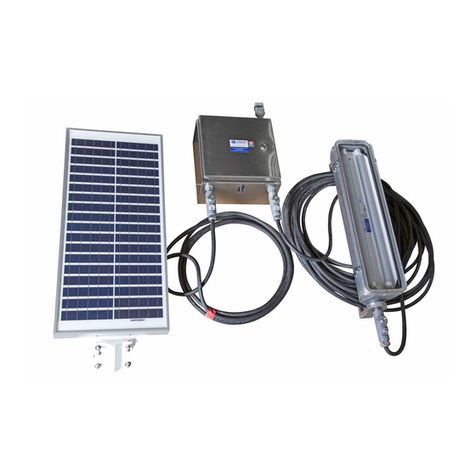
Larson Electronics
Larson Electronics HAL-24-2L-LV-SOL-80C-C1D2-20C User manual

Larson Electronics
Larson Electronics HAL-SPK-2X150PNL-SCS-2X100AH-24-PLC User manual
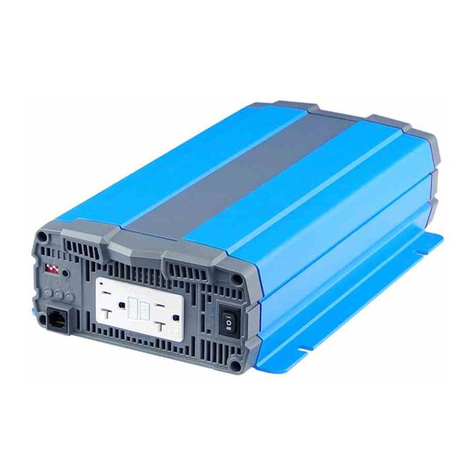
Larson Electronics
Larson Electronics SPLT IVT-12VDC-1000VA-120VAC Series User manual

Larson Electronics
Larson Electronics LEDEMG-400VA Owner's manual
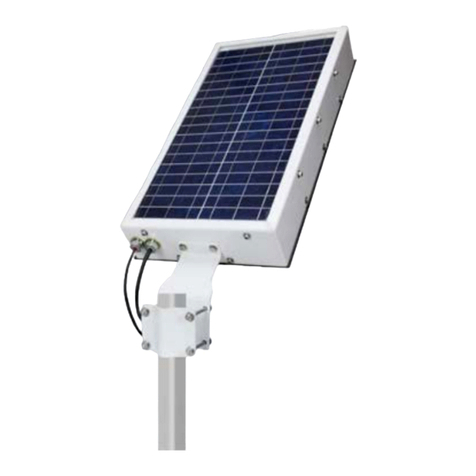
Larson Electronics
Larson Electronics SPEPSN-HRN-PA Manual
